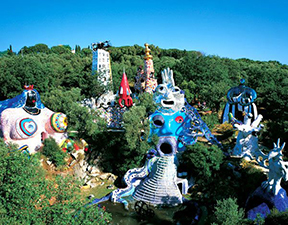 Niki de Saint Phalle’s Tarot Garden. Photo © Nohra Haime
Niki de Saint Phalle’s Tarot Garden. Photo © Nohra Haime
In the Italian village of Capalbio, in the late nineteen-seventies, two peculiar things happened: the mail started arriving late, and people began whispering about the “monsters” rising up in the hills nearby. At first, the monsters looked like massive, misshapen iron cages emerging from the Tuscan countryside. Then they went white. Plaster was spread over the metal, and the monsters became looming, creamy ghosts. Finally, they started turning colors: blue, orange, shocking pink.
Although no one suspected it, there was a connection between these two occurrences. The postman, Ugo Celletti, had been helping to create the monsters-tremendous sculptures growing on the grounds of a local estate. He’d discovered a passion for mosaic work, and as he applied slivers of mirrored glass to the monsters he sometimes forgot about his postal route. Like many other people in the area, Celletti had his life altered by the mother of the monsters, who came to Italy to build a sculpture garden that she had envisioned in a dream, decades earlier, when she was locked in an asylum: the artist Niki de Saint Phalle.
What Saint Phalle, who died in 2002, left behind in Tuscany is dazzling or deranged, transcendent or tawdry, depending on whom you ask. Amid peaceful olive groves and ochre fields grazed by horses and sheep sits a house-size sculpture of a sphinx, with mirrored blue hair and a bright-red crown, a flower blooming on one of her breasts and a lavender heart on the nipple of the other. The interior is covered in shards of mirror, as if a colossal disco ball had been turned inside out. (During the two decades that Saint Phalle worked on the garden, her bedroom was inside one breast, her kitchen in the other.) A sprawling, fantastical castle, with a rainbow mosaic tower, sits near a blue head some fifty feet high, sprouting a second, mirrored head crowned by a huge hand. Downhill, the Devil stands amid some shrubs, a rainbow-winged hermaphrodite with a sweet face, womanly hips, and three gold penises. It is as if a psychedelic bomb had exploded in the most picturesque part of Tuscany.
When Saint Phalle entered the asylum, in the early nineteen-fifties, she was a twenty-two-year-old wife, mother, erstwhile fashion model, and lapsed French aristocrat. Art, she believed, returned her to sanity, and she wanted to make a monumental sculpture garden that would, in turn, heal others. It would be in the fanciful style of Antoni Gaudí’s Park Güell, in Barcelona, but each structure would represent a mystical figure from the tarot deck. She would create an alternate reality-“a sort of joyland,” she once said, “where you could have a new kind of life that would just be free.”
In the decades after her recovery, Saint Phalle became a star. In the sixties, she caused a sensation with her “shooting paintings.” She would fire a rifle at assemblages of knives, scissors, eggbeaters, and baby-doll arms-the detritus of domesticity-which she had embedded in plaster, along with bags of paint and the occasional tomato. When the bullets hit, the art started “bleeding.” Jane Fonda attended a shooting in Malibu; Robert Rauschenberg bought one of the paintings.
NOHRA HAIME GALLERY
730 Fifth Avenue, NYC, NY 10019
212-888-3550
[email protected]